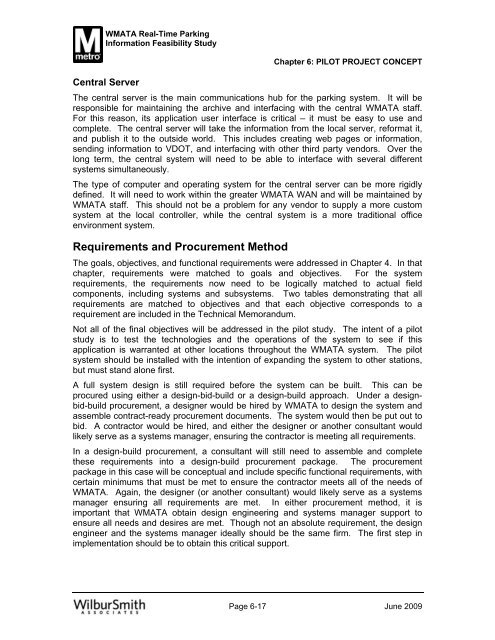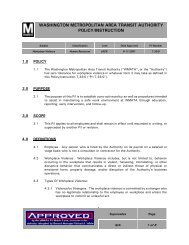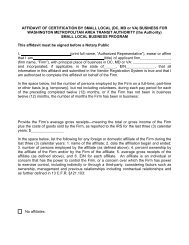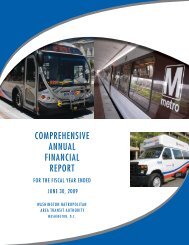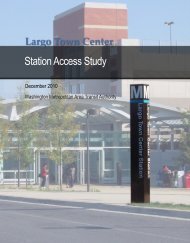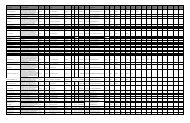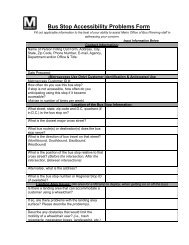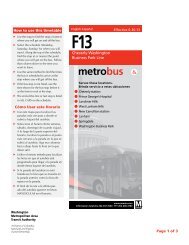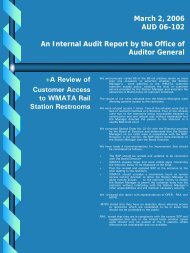feasibility study of real time parking information at ... - WMATA.com
feasibility study of real time parking information at ... - WMATA.com
feasibility study of real time parking information at ... - WMATA.com
Create successful ePaper yourself
Turn your PDF publications into a flip-book with our unique Google optimized e-Paper software.
<strong>WMATA</strong> Real-Time Parking<br />
Inform<strong>at</strong>ion Feasibility Study<br />
Central Server<br />
Chapter 6: PILOT PROJECT CONCEPT<br />
The central server is the main <strong>com</strong>munic<strong>at</strong>ions hub for the <strong>parking</strong> system. It will be<br />
responsible for maintaining the archive and interfacing with the central <strong>WMATA</strong> staff.<br />
For this reason, its applic<strong>at</strong>ion user interface is critical – it must be easy to use and<br />
<strong>com</strong>plete. The central server will take the <strong>inform<strong>at</strong>ion</strong> from the local server, reform<strong>at</strong> it,<br />
and publish it to the outside world. This includes cre<strong>at</strong>ing web pages or <strong>inform<strong>at</strong>ion</strong>,<br />
sending <strong>inform<strong>at</strong>ion</strong> to VDOT, and interfacing with other third party vendors. Over the<br />
long term, the central system will need to be able to interface with several different<br />
systems simultaneously.<br />
The type <strong>of</strong> <strong>com</strong>puter and oper<strong>at</strong>ing system for the central server can be more rigidly<br />
defined. It will need to work within the gre<strong>at</strong>er <strong>WMATA</strong> WAN and will be maintained by<br />
<strong>WMATA</strong> staff. This should not be a problem for any vendor to supply a more custom<br />
system <strong>at</strong> the local controller, while the central system is a more traditional <strong>of</strong>fice<br />
environment system.<br />
Requirements and Procurement Method<br />
The goals, objectives, and functional requirements were addressed in Chapter 4. In th<strong>at</strong><br />
chapter, requirements were m<strong>at</strong>ched to goals and objectives. For the system<br />
requirements, the requirements now need to be logically m<strong>at</strong>ched to actual field<br />
<strong>com</strong>ponents, including systems and subsystems. Two tables demonstr<strong>at</strong>ing th<strong>at</strong> all<br />
requirements are m<strong>at</strong>ched to objectives and th<strong>at</strong> each objective corresponds to a<br />
requirement are included in the Technical Memorandum.<br />
Not all <strong>of</strong> the final objectives will be addressed in the pilot <strong>study</strong>. The intent <strong>of</strong> a pilot<br />
<strong>study</strong> is to test the technologies and the oper<strong>at</strong>ions <strong>of</strong> the system to see if this<br />
applic<strong>at</strong>ion is warranted <strong>at</strong> other loc<strong>at</strong>ions throughout the <strong>WMATA</strong> system. The pilot<br />
system should be installed with the intention <strong>of</strong> expanding the system to other st<strong>at</strong>ions,<br />
but must stand alone first.<br />
A full system design is still required before the system can be built. This can be<br />
procured using either a design-bid-build or a design-build approach. Under a designbid-build<br />
procurement, a designer would be hired by <strong>WMATA</strong> to design the system and<br />
assemble contract-ready procurement documents. The system would then be put out to<br />
bid. A contractor would be hired, and either the designer or another consultant would<br />
likely serve as a systems manager, ensuring the contractor is meeting all requirements.<br />
In a design-build procurement, a consultant will still need to assemble and <strong>com</strong>plete<br />
these requirements into a design-build procurement package. The procurement<br />
package in this case will be conceptual and include specific functional requirements, with<br />
certain minimums th<strong>at</strong> must be met to ensure the contractor meets all <strong>of</strong> the needs <strong>of</strong><br />
<strong>WMATA</strong>. Again, the designer (or another consultant) would likely serve as a systems<br />
manager ensuring all requirements are met. In either procurement method, it is<br />
important th<strong>at</strong> <strong>WMATA</strong> obtain design engineering and systems manager support to<br />
ensure all needs and desires are met. Though not an absolute requirement, the design<br />
engineer and the systems manager ideally should be the same firm. The first step in<br />
implement<strong>at</strong>ion should be to obtain this critical support.<br />
Page 6-17 June 2009


